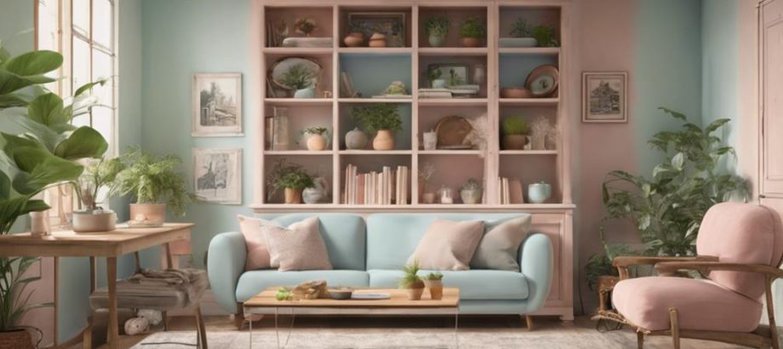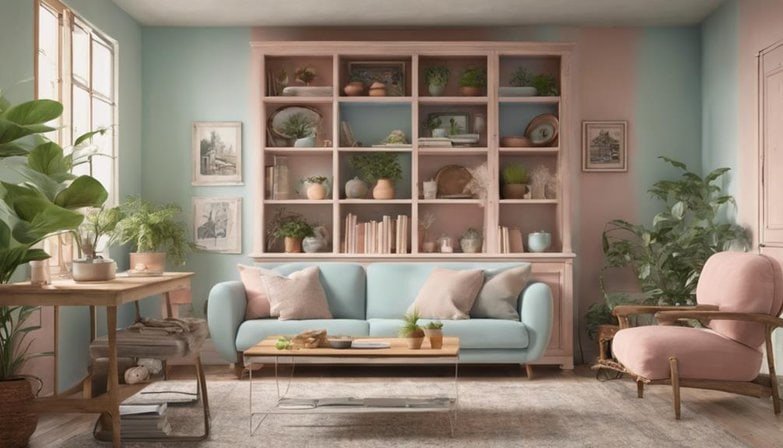Is Chalk Paint Good for Interior Walls? Uses and Benefits


Chalk paint is an excellent choice for interior walls if you aim for a matte, vintage look. It requires minimal prep work and adheres well to different surfaces. You’ll appreciate its ability to conceal minor imperfections and its fast-drying properties. Perfect for quick room makeovers, chalk paint also allows you to experiment with distressing and layering techniques.
Chalk paint emits low VOCs, making it safer for your home environment. For the best results, remember it takes about 1-3 weeks to fully cure. If you’re keen on creating a cozy, inviting atmosphere, there’s more useful information ahead.
Key Takeaways
- Chalk paint creates a cozy, inviting atmosphere with a matte, vintage look for interior walls.
- It adheres well to various surfaces, requiring minimal prep work for quick makeovers.
- Excellent for concealing minor imperfections, providing a smooth, velvety finish.
- Fast-drying properties make it convenient for DIY projects and room transformations.
- Allows for artistic techniques like distressing and layering, enhancing decorative finishes.
What are Chalk Paints Best For?
Chalk paints are best for giving walls a matte, vintage look with minimal surface preparation. When you’re aiming for that timeless, antique charm, chalk paint is your go-to solution. It excels in furniture restoration, transforming old pieces into elegant, stylish items that fit perfectly with vintage aesthetics. The matte finish of chalk paint adds a soft, chalky texture that can make any wall or piece of furniture look like it’s stepped out of a different time period.
To get started, you don’t need to spend hours sanding or priming your surfaces. Chalk paint adheres well to most materials, including wood, metal, and even previously painted surfaces. This makes it incredibly user-friendly, especially if you’re new to DIY projects. Just clean the surface, and you’re ready to paint. Also, you can experiment with different techniques like distressing or layering colors to capture that vintage feel.
For walls, a matte finish can make a room feel cozy and inviting, while also concealing minor imperfections. So, if you’re looking to add character and charm to your walls or furniture, chalk paint is a versatile and efficient choice.
Are there Chalk Paints Benefits?
Offering a unique blend of style and practicality, chalk paints bring numerous benefits to your interior design projects. One of the standout features is their ability to create beautiful decorative finishes with minimal effort. Whether you’re aiming for a modern or vintage look, chalk paint can easily adapt to your vision.
The easy application is another significant advantage. Unlike traditional paints, chalk paints require little to no prep work. You can often skip sanding and priming, making it a convenient choice for quick makeovers. Plus, it adheres well to different surfaces, including wood, metal, and even fabric.
For those who love a distressed look, chalk paint is a game-changer. It’s perfect for achieving that shabby chic aesthetic, thanks to its natural matte finish and versatility in layering and distressing techniques. This allows you to create a unique, mature appearance that adds character to any room.
- Decorative finishes: Offers a variety of styles, from modern to vintage.
- Easy application: Minimal prep work required, sticks to many surfaces.
- Distressed look: Ideal for creating mature, shabby chic designs.
These benefits make chalk paint a valuable tool in your interior decorating arsenal.
When to use Chalk Paints?
Given the numerous benefits of chalk paints, you might wonder when it’s best to use them for your interior projects. Chalk paint is exceptionally versatile and can elevate a variety of surfaces. Here’s when you should consider using it:
- DIY Projects: Chalk paint is perfect for transforming old furniture or creating custom pieces. Its ease of use and minimal prep work make it ideal for DIY enthusiasts.
- Decorative Accents: Use chalk paint to add decorative accents to walls, frames, and other home décor items. Its matte finish and variety of colors can bring a unique charm to any space.
- Vintage Finishes: If you love the shabby chic or vintage look, chalk paint can help you achieve that distressed, mature appearance effortlessly.
- Quick Makeovers: When you need a quick room makeover, chalk paint’s fast-drying properties and ability to cover surfaces with minimal coats are invaluable.
- Textured Surfaces: Chalk paint works well on textured surfaces, allowing you to create interesting visual effects and finishes.
Here’s a quick reference table to help you decide:
| Use Case | Benefit |
|---|---|
| DIY Projects | Easy to apply, minimal prep work |
| Decorative Accents | Adds unique charm and character |
| Vintage Finishes | Achieve distressed, mature appearance |
| Quick Makeovers | Fast-drying, minimal coats needed |
| Textured Surfaces | Elevates visual effects and finishes |
Drying and Curing Times
You’ll find that the drying and curing times for chalk paint are relatively quick, making it an excellent choice for time-sensitive projects. Chalk paint’s drying duration typically ranges from 30 minutes to a few hours, depending on factors like room temperature and humidity. This allows you to apply multiple coats in a single day, which is perfect for busy schedules.
When it comes to application techniques, chalk paint is quite forgiving. You can use a brush, roller, or even a sprayer to achieve the desired finish. What’s crucial is to allow each coat to dry thoroughly before adding another layer.
To help you visualize the process, consider the following:
- Drying Duration: Usually between 30 minutes to 2 hours.
- Application Techniques: Brush, roller, or sprayer.
- Curing Process: Takes about 1-3 weeks for the paint to fully cure.
The curing process is vital as it ensures the paint reaches its maximum hardness and durability. While the paint may feel dry to the touch within hours, it requires additional time to cure completely. Patience during the curing process guarantees a long-lasting, beautiful finish on your interior walls.
Is Chalk Paint good for Living room and Bedroom?
When deciding whether chalk paint is good for your living room and bedroom, consider its unique aesthetic and practical benefits. Chalk paint offers a matte finish that can add a charming, rustic feel to your spaces. One of its main advantages is the variety of color choices available, allowing you to match your decor easily. From soft pastels to bold hues, you can find the perfect shade for your living room or bedroom.
Application methods for chalk paint are straightforward, making it accessible even for DIY enthusiasts. You don’t need to be an expert; a simple brush or roller will do the trick. Its thick consistency means you often only need one or two coats, saving you time and effort. Plus, chalk paint adheres well to different wall textures, whether your walls are smooth or slightly rough.
Another benefit is its ability to create interesting wall textures. You can easily distress the paint to achieve a vintage look or use layering techniques for added depth. This versatility makes chalk paint an excellent choice for personalizing your living room and bedroom, giving them a unique and cozy atmosphere.
Is Chalk Paints Safe for Health?
In recent years, concerns about the safety of chalk paint for health have become increasingly significant for homeowners. Chalk paint is often praised for its low VOC emissions, making it a vital choice compared to traditional paints. VOCs, or volatile organic compounds, can negatively impact indoor air quality and pose health risks, but most chalk paints contain little to no VOCs.
However, while chalk paint itself is relatively safe, application and maintenance can introduce health risks:
Dust inhalation: Sanding chalk paint creates fine dust particles that can be harmful if inhaled. Always wear a mask and guarantee proper ventilation.
Child safety: Chalk paint is generally non-toxic, but it’s still important to keep children away from freshly painted surfaces and tools.
Allergic reactions: Some individuals may have sensitivities to specific ingredients in the paint. Conduct a patch test before extensive use.
How to tell if Paint is Chalk?
Understanding the safety aspects of chalk paint is crucial, but recognizing whether a paint is chalk can be just as essential for your project.
To identify chalk paint, start by examining its identifying characteristics. Chalk paint typically has a matte, velvety finish that gives surfaces a classic, vintage look. Unlike glossy or satin paints, it lacks any shine, which makes it stand out.
Next, focus on texture differences. Chalk paint has a thicker, more viscous texture compared to regular latex or acrylic paints. When you dip your brush into chalk paint, you’ll notice it feels creamier and more substantial. This texture allows for excellent coverage, often requiring fewer coats.
Lastly, consider the paint composition. Chalk paint is made with a combination of calcium carbonate, talc, and pigment, which distinguishes it from other types of paint. You can sometimes tell by reading the label or product description. Many commercial chalk paints will explicitly state their composition, but if you’re unsure, look for terms like “calcium carbonate” or “talc” in the ingredients list.
Frequently Asked Questions
Can Chalk Paint Be Used on Exterior Walls?
You can use chalk paint on exterior walls, but it’s not ideal. It lacks weather resistance, UV protection, and outdoor durability. For better results, choose exterior-specific paints designed to withstand harsh weather and sunlight.
How Do You Seal Chalk Paint on Walls?
To seal chalk paint on walls, use sealing techniques like wax application or protective coatings. Apply a clear wax evenly for a smooth finish, or use a polyurethane coating for more durability and protection.
Does Chalk Paint Require a Primer on Walls?
You don’t always need a primer with chalk paint, but surface preparation is essential. Clean the walls thoroughly and make sure they’re smooth. Alternative options for primer include using a diluted initial coat to improve paint consistency and adhesion.
Can Chalk Paint Cover Dark-Colored Walls Effectively?
Yes, chalk paint can cover dark-colored walls effectively. You should use proper coverage techniques, like multiple coats. Check out different color options, and apply smoothly with good brushes or rollers for best results. Follow these application tips for success.
How Long Does Chalk Paint Last on Interior Walls?
Chalk paint’s application duration depends on your maintenance tips and how well you handle paint aging. With proper care, it can last several years. Regular cleaning and occasional touch-ups will extend its lifespan substantially.
